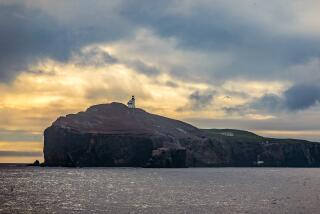The Corn Islands: Paradise au naturel
- Share via
Little Corn Island, Nicaragua — THIS is the way you picture island resorts looking 50 years ago.
Standing on the tiny municipal pier of Little Corn Island, about 40 miles off eastern Nicaragua, I can see fishermen and pastel-colored casitas and jungle.
It is bliss — but it’s no St. Bart’s.
FOR THE RECORD:
Corn Islands: An April 8 article in Travel about Nicaragua’s Corn Islands incorrectly spelled the name of Casa Iguana’s staff fisherman. He is Brendon Efaw, not Brandon Efax. —
If your idea of a Caribbean vacation includes facials, room service and $25 breakfasts, head to those islands whose names start with “Saint.” But if strapping on a pair of hiking boots, slathering yourself in high-test mosquito repellent and trekking through the jungle to deserted beaches quickens your pulse, Little Corn or its sister, Great (also called Big) Corn, are your ticket.
High-end amenities here include hot water, 24-hour electricity and $11 lobster dinners.
During my visit in January, I overheard Canadian and European tourists say, “I wanted to go to Costa Rica, but it’s too expensive and built up.”
So they’re here instead, at a place with no golf resorts, few tourists and zero paparazzi. At a place poised somewhere between adolescence and adulthood: striving to be St. Thomas but still in its awkward “Pirates of the Caribbean” stage — treehouses and jungle cabins, Ramón the Spaniard and Paola the Italian.
When I told friends I was coming to the Corn Islands for adventure and cheap lobster, their faces went blank. They shouldn’t have felt embarrassed about their geographical ignorance, though. The Corns are far off the travel grid, but the payoff is solitude, scenery and some of the best fishing, diving and snorkeling in the Caribbean, at bargain prices. The bonus: no driving necessary. On Great Corn, there are only rented golf carts ($31 for three hours) and taxis ($1 per person anywhere on the island) for tourists; on Little Corn, there are no cars — or roads for that matter.
All the better for what I had in mind.
Colorful history
THE Corn Islands were first inhabited by the Sumu and Kukra Indians, according to “Meet Corn Island,” Rodwell Morgan’s historical book. By the 16th century, British, Dutch and French pirate ships were menacing these waters, attacking and robbing the Spanish vessels carrying gold and other treasures from Central and South America back to the mother country.British settlers from Jamaica began moving to the Corn Islands in the 18th century, bringing their African slaves with them. Most of the islanders today are descendants of those settlers and speak English. The Nicaraguan “mainlanders” speak Spanish.
Locals and tourists plopped themselves and their bags aboard our 15-passenger panga, an open boat that zipped us the nine miles from Great Corn Island to Little Corn. When it pulled alongside the pier after the 25-minute, jowl-jostling crossing, I knew immediately that I had left Nicaragua’s last outpost of civilization. No roads, no doctors, a smattering of hostelries and restaurants, sketchy phone reception, one Internet connection.
A porter, Lolo, greeted me, tossed my luggage on his wheelbarrow and we headed out. We strolled through a slice of the tiny town to a dirt path heading east through the jungle. After about a quarter-mile, we reached 12 brightly colored casitas that make up Casa Iguana.
Along the way, cat-size reptiles scurried across the trail. Lolo laughed at my reaction. “They’re nothing,” he said. “Wait till you see the boas.” I didn’t tell him that it’s spiders, not snakes, that make me squirm, but either way, I would have a phobic moment. But more on that later.
Casa Iguana is summer camp for grown-ups. I was immediately smitten with my no-frills, purple-and-yellow cabin with the double mattress atop a wooden frame, the sofa that had seen better days and especially the view from my wind-swept patio facing the sea, all for $55 a night. I had my own toilet and sink en suite; the shower was outdoors. Its one valve — cold — came in handy that evening.
Little Corn is but one square mile, and most of it is jungle. Pedestrians and bicyclists use a paved walkway that runs along part of the isle’s western side. Getting to the other side, which is all pristine shoreline, requires a hike through the tropical forest. I was game.
After telling Casa Iguana’s manager that I would be eating there that evening — the hotel requires a head count each morning so the staff can catch enough fish for the evening meal, served family style in the lodge — I headed for the Dolphin Dive shop near the pier, where I picked up a hand-drawn map.
“Go up to Bridget’s place and turn right,” I was told by Sandra Herman, the shop’s manager, “and you’ll see a path that takes you through the jungle to Derek’s Place.”
Bridget? Derek?
I walked 50 yards north to an unremarkable house (Bridget’s, it turned out) and headed east. Within minutes, I was on a dirt trail, surrounded by ferns, palms trees, butterflies and hanging vines, with coconuts along the path.
The trail was solitary and quiet, other than the squawking of birds, on my half-hour trek to the eastern side of the island. I turned north when I saw the sea in front of me. Ten minutes later, I stumbled upon Derek’s Place. Hello, 1960s.
It’s easy to pick out Derek Sharp. He’s tall, his thinning, long strawberry-blond hair tied at the nape of his neck. A haphazard braid hangs from his chin.
Sharp, 32, staked out his corner of nirvana about eight years ago and set about building four jungle cabins, each different, each splendid, each costing $10 to $40 per night, depending on the number of guests occupying it. Think upscale Robinson Crusoe: casitas with palm-thatched roofs atop wooden piers. The interior walls have hand-painted murals; lofts have foam-pad beds and mosquito netting; hammocks hang between porch posts.
This Shangri-La, blanketed in a carpet of grass and thick with tall palms, attracts backpackers mostly, but a more varied clientele has recently begun staying here, Sharp said.
Everyone shares the compound’s bathroom. Chickens and roosters — “dinner,” when guests tire of fresh fish — wander around the spread; a worker breaks open piles of coconuts for snacks. Just feet away is an empty, white-sand beach.
“I like the freedom here,” Sharp said. “If you have an idea, you can make it happen.”
Others in this corner of the world had the same epiphany too. Ten minutes northwest of Derek’s Place, past a gorgeous stretch of beach to my right and jungle to my left, I came across a sign directing me to Farm Peace & Love.
The proprietors of this outpost, in a large clearing and surrounded by a wild garden, are Paola Carminiani, an Italian expat, and her husband, Bing Crosby Downs, an islander. They rent out a guest room attached to their own house, for $50 for two guests and $60 for three, and a separate guest cottage, for $75 nightly.
Carminiani arrived on Little Corn Island 10 years ago, seeking peace and quiet. “I prefer no phones, few people, no noise,” she said. She got it.
The expat runs a patio restaurant out of her house. Three-course dinners cost $12 to $15. Reservations are made by radio from Casa Iguana’s dive shop. Carminiani also offers 90-minute guided horseback rides along the island’s northeastern shore, for $25.
I couldn’t resist, but I wish I had.
Touting my equestrian skills, which, truth be told, are only so-so, I climbed on the back of Aziz, the feistier of Carminiani’s horses. About 100 yards up the shore, Aziz dropped to his knees like a camel. I hopped off and watched as he twisted on his back, then loped into the sea, cooled off and headed home. Good idea, I thought, wishing I could escape the heat myself.
Carminiani had some choice words for the horse — and for me — but back at her peace-and-love pad, she refused to accept payment for the misadventure, handed me a bottle of cool water and directed me to Ensueños, her neighbors’ spread to the west.
Ensueños, which means “dreamy” in Spanish, is just that. Each of the three guest cabanas, designed and constructed by Ramón Gil — an artist and former biologist from Spain — is different, but all are made of cane, palms, shells, driftwood and other natural items. There is no electricity, so candles illuminate the Hobbit-like cabins. Sections of the floors are of painted concrete; others are sand. The cozy dwellings — $5 to $20 per night per person — are tucked into the forest. A nearby dormitory, with two beds and a host of hammocks, is $5 per person per night.
Gil, barefoot and sporting a bandana around his closely cropped head, resembles Picasso and oozes charisma. He and his French partner, Marine Laurent, greeted me warmly and insisted I sample a sweet fruit drink brewing on the stove.
Gil arrived on Little Corn in 1997 and says he will never leave.
“It’s perfect here,” he said.
I hated to leave this idyll myself, but dusk suddenly fell like a cloak. Lacking a flashlight, I needed to get back to my own quarters. Half an hour later, the moon lighting the last part of the hike, I arrived at Casa Iguana in time for dinner.
Howling at the wolfs
EVERYONE, including the cooks, sits down for the evening meal at 7 o’clock sharp. The menu is simply the catch of the day and some vegetables and plenty of wine and beer.Conversation the first night drifted to the wolf spider that Casa Iguana guests Anne and Chris Thompson had encountered on the wall above their bed the previous night. Anne, a wildlife lover from Alberta, Canada, thought it would be cool to photograph the hairy arachnid, the size of a baseball and way attitudinal. It jumped at her as she clicked the shutter.
“I heard that scream,” said Brandon Efax, the hotel’s fisherman. “Whenever I hear a scream here it’s because of the wolfs.” Wolfs? There would be no sleeping in that cabin if I were sharing it with spiders as big as my head. So, I persuaded Efax to check out every inch of my cabin before I retired. On the way there, flashlights in hands, we nearly stumbled over scores of hermit crabs, moving in a single, undulating mass near my casita, something I was told they do at every full moon. At least they were outdoors. Inside, no sign of spiders.
“They like to hide,” Efax said. “Sleep well.”
I did.
I set off in the morning to experience Little Corn Island’s main draw: diving and snorkeling. I accompanied four divers to White Holes, a white coral reef a 10-minute speedboat ride off the northern end of the island.
I’m not certified to dive, but I snorkeled above the others for an hour, awed as nurse sharks lazed along the bottom and barracudas cruised by. Two spotted eagle rays swept up from the sea floor 30 feet below, and drifted right under me.
“The primitiveness of this place makes the hard work of getting here worth it,” said Dennis Bowmen, an avid diver from Austin, Texas, who knows all the best Central American dive spots and rates Little Corn waters highly. “I’m concerned that someone with a ‘vision’ will come here, though, and change this place. Best to see it now.”
I heard that often on my visit here.
‘This is perfect’
TWO days before my Little Corn adventure, Austrian cook Walter Schleiffer and his wife, Alexandra Weiss, were the only sunbathers on a wide expanse of what is considered Great Corn Island’s best beach.Resting on chaises under palm trees on the western end of the island in front of the Arenas Beach Hotel, they raved about the lack of tourists and the inexpensive hotels and restaurants.
“This is perfect, with one exception,” Weiss said. “There is no shopping.”
Great Corn does have a little centro in Brig Bay, the “downtown” area between the airport and the municipal docks. Vendors sell fruits and vegetables, children’s knapsacks, souvenir T-shirts and the like. There are about a dozen such shops, one just like the other.
Possessed of fair skin and almost zero tolerance for sunbathing and buying tchotchkes, I rented a golf cart for three hours and tooled around the island. That’s how I discovered Sandra Watts’ coco-bread shop across from the airstrip. Locals line up outside her modest bakery at all hours to devour those homemade, sweet-tasting confections that melt your insides. She also sells “patties,” little meat- or plantain-filled pies, that locals buy after work, each for less than a dollar.
I also climbed 365-foot Mt. Pleasant, the highest peak on the island. After a 20-minute walk through dense foliage and past brightly colored houses, I reached the top to behold a breathtaking 360-degree vista of Great Corn’s white-sand beaches, mangrove swamps in the center of the island and turquoise water on all sides.
The logical activity after that scorching hike was a dip in the island’s only infinity pool — its only pool, for that matter — at Casa Canada, my hotel. Hugging the eastern shoreline, it has 20 ocean-facing casitas, at $85 a night, double occupancy. It’s the nicest hotel on the island, in my opinion, and the one with the most North American amenities (refrigerator in the room, TV, air conditioning); its patio restaurant, which faces the sea, also serves fresh-fish dinners daily, priced from $9 to $16.
Diving and fishing are the big deal on Great Corn. The best snorkeling can be reached by foot (or fin) at Anastasia’s on the Sea, on the eastern side of the island.
From this hotel, which also rents kayaks and fishing rods and offers sport-fishing trips, snorkelers can walk out 60 feet and explore the reef for $3 an hour.
Anastasia’s co-owner, Robert Finley, a North Carolina native and fishing aficionado, says the fly-fishing on Great Corn is the best on the planet.
“You can troll near shore and get kings, mackerel, barracuda, mahi-mahi, grouper, snapper — I’ve caught some that are 40 pounds,” he said.
OK, so everyone has a fish story. But only on the Corn Islands, it seems, does everyone have a lobster-eating story.
“Once I ate three in one day,” a tourist said as he waited for the panga back to Great Corn.
“I can eat 12 in three days,” a local boasted.
The crustaceans are caught daily and prepared any way your imagination takes you, for $16, tops (and usually much less).
My best dinner on Great Corn, however, was the grilled barracuda I inhaled along with beans and plantains, for $8, at Paraiso Club, a hotel near the airstrip. As is typical of the Corns’ relaxed atmosphere, tourists from adjoining tables wandered over to my table to toss back some beer and swap stories with Ton Bos, Paraiso’s co-owner, and me.
“You come to Big Corn, away from the crowds, pull up a lounge chair, and there are two people on the beach, not 4,000 like the rest of Central America,” said Richard Hewson, 52, from Saskatchewan, Canada. “You’ve got your bottle of rum, a Caribbean view, you’re in paradise, man.”
Amen to that.
diane.wedner@latimes.com
*
(INFOBOX BELOW)
Planning this trip
THE BEST WAY
From LAX, Delta offers nonstop service to Managua, and connecting service (change of plane) also is available on Delta, Continental, American, Taca and Lacsa. Restricted round-trip fares begin at $382.Connecting service is offered on La Costeña and Atlantic airlines in Managua. Restricted round-trip fares begin at $164. Panga rides daily from Great Corn’s Brig Bay Municipal Wharf to Little Corn Island for $7.50 each way.
ABOUT THE CORN ISLANDS
Great Corn Island offers more North American-style amenities than Little Corn, such as all-day electricity, roads and taxis. Optimum time to visit: December through April. Hotel reservations are necessary only during Christmas and Easter vacation times.WHERE TO EAT
Paraiso Club Restaurant, southwestern side of Great Corn Island: Delightful patio dining, great seafood. Main dishes from $7.50 to $13.Hotel Morgan, eastern side of Great Corn, Caribbean flair. Main courses from $6.50 to $14. Lobster’s the big deal on the island; never more than $16.
Habana Libre, on the main strip of Little Corn Island. Good seafood, with Cuban flavor. Lunch $6 to $10.
Farm Peace & Love, a 30-minute walk north from town on Little Corn. Three-course Italian dinners from Paola Carminiani’s kitchen, for $15; reservations through Casa Iguana Dive Shop. https://www.farmpeacelove.com .
TO LEARN MORE
For information about the islands, visit https://www.bigcornisland.com or https://www.vianica.com/visit/corn-islands .On travel.latimes.com
The sights and sounds of the Corn Islands
Travel along with a video of this unspoiled Nicaraguan hideaway.More to Read
Sign up for The Wild
We’ll help you find the best places to hike, bike and run, as well as the perfect silent spots for meditation and yoga.
You may occasionally receive promotional content from the Los Angeles Times.






